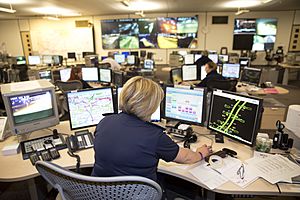Managed motorway facts for kids
Managed motorways are special sections of motorways in the United Kingdom. They use smart technology to help traffic flow better, especially when roads are busy. This system is also called active traffic management.
The main goal of managed motorways is to make sure more cars can use the road smoothly. They do this by changing the speed limits and sometimes letting cars drive on the hard shoulder. A hard shoulder is usually a lane only for emergencies, but on managed motorways, it can open for regular traffic during peak times.
This smart system first started in 2005. Today, you can find managed motorways on parts of the M1, M4, M6, and M42. There are also plans to use them on the M5, M25, M60, and M62.
Managed motorways help in many ways. They make traffic move more easily and help you get to your destination on time. They can also make roads safer and reduce noise and pollution from cars. If a motorway only uses variable speed limits without opening the hard shoulder, it's called a controlled motorway.
Contents
How Managed Motorways Work
Managed motorways use clever technology to control traffic. This helps prevent traffic jams and makes journeys smoother.
Variable Speed Limits
One important part of managed motorways is the use of variable speed limits. Large electronic signs above the road show different speed limits. These limits can change depending on how busy the road is or if there's an accident ahead.
- When traffic is heavy, the speed limit might be lowered. This helps cars keep moving instead of stopping and starting.
- If the road is clear, the speed limit might go back up.
- Following these changing limits helps traffic flow more evenly. It also makes the road safer for everyone.
Hard Shoulder Running
The hard shoulder is usually a lane on the side of the motorway for emergencies only. On managed motorways, this lane can sometimes be opened for regular traffic. This is called hard shoulder running.
- When traffic gets very busy, signs above the hard shoulder will show a green arrow. This means you can use it as an extra lane.
- If the hard shoulder is closed, a red 'X' will appear above it. You must not drive on it then.
- Opening the hard shoulder adds more space for cars. This helps reduce congestion during busy times.
Benefits of Managed Motorways
Managed motorways bring several good things to our roads. They are designed to make travel better for drivers and the environment.
Smoother Journeys
One of the biggest benefits is that traffic flows more smoothly. By managing speed and opening extra lanes, cars are less likely to get stuck in stop-and-go traffic. This means less frustration for drivers.
More Reliable Travel Times
Because traffic moves more smoothly, your journey times become more predictable. You are more likely to arrive at your destination on time, which is great for planning trips.
Increased Safety
Managed motorways can also make roads safer. By controlling speeds and reducing sudden braking, there are fewer accidents. The system helps warn drivers about problems ahead, like slow traffic or incidents.
Less Pollution
When cars move smoothly instead of constantly stopping and starting, they use less fuel. This means they produce fewer harmful gases, which is better for the air we breathe. It also helps reduce noise from traffic.
Images for kids
-
A section of controlled motorway on the M25 in Hertfordshire
-
M42 with hard shoulder running in the West Midlands. It is shown as closed while the ordinary lanes have a mandatory 40mph speed limit.
-
A stretch of the M25 in Hertfordshire, where the motorway operates as four-lane running without a hard shoulder between J23-27






